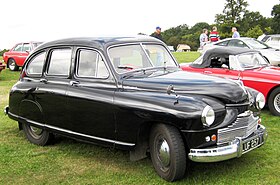| Standard Vanguard | |
|---|---|
 1951 Standard Vanguard Phase I Saloon | |
| Overview | |
| Manufacturer | Standard Motor Company |
| Production | 1948–1963 |
| Assembly | United Kingdom Australia New Zealand (Motor Assemblies)[1] |
| Chronology | |
| Predecessor | Standard Fourteen |
| Successor | Triumph 2000 Standard Atlas (Utility models) |
The Standard Vanguard is a car which was produced by the Standard Motor Company in Coventry, England, from 1947 until 1963.
The car, announced in July 1947, was completely new, with no resemblance to previous models. Designed in 1945,[2] it was Standard's first post-World War II car and intended for export around the world. It was also the first model to carry the new Standard badge, which was a heavily stylised representation of the wings of a griffin.[3]
In the wake of World War II, many potential customers in the UK and in English-speaking export markets had recently experienced several years of military or naval service, and therefore a car name related to the Royal Navy carried a greater resonance than it would for later generations. The name of the Standard Vanguard recalled HMS Vanguard, the last of the Royal Navy's battleships, launched in 1944 amid much media attention; permission to use the name involved Standard in extensive negotiations with senior Royal Navy personnel.
The Vanguard was first exhibited to the public at the Brussels Motor Show in February 1948.[4] It began to come off the assembly lines in the middle of 1948 but all production was allotted to the export trade.[5] An estate car and a utility pick up version were announced in September, and then a 12 cwt delivery van.[6] Aprons were fitted over the Vanguard's rear wheels from September 1949.[7]
In 1950,[8] the Vanguard and the Triumph Renown were the first cars to be fitted with a Laycock de Normanville overdrive. The Laycock overdrive operated on the second and third gears of the three-speed transmission, creating, in effect, a five-speed gearbox.
In Scandinavia, Standard marketed the Standard Ten saloon as the Vanguard Junior.
- ^ Webster 2002, pp. 71–72.
- ^ Standard Motor Company, Business and Finance The Times (London, England), 10 November 1947 page 8
- ^ The Standard Car Review. January 1947.
{{cite journal}}: Missing or empty|title=(help) - ^ Brussels Motor Show The Times, 14 February 1948 page 3
- ^ News in Brief The Times 2 June 1948 page 3
- ^ The Standard Vanguard The Times 23 September 1948 page 2
- ^ Motor Show To-Day The Times, 28 September 1949 page 4
- ^ An Overdrive Gear The Times 6 June 1950 page 2